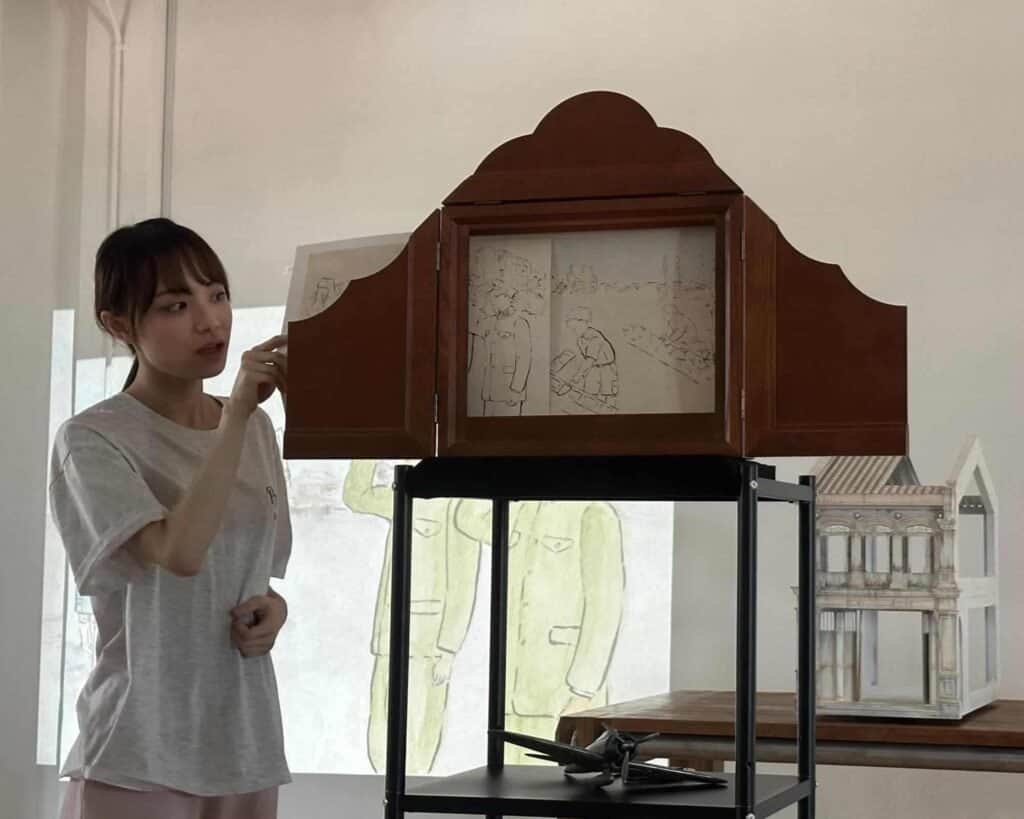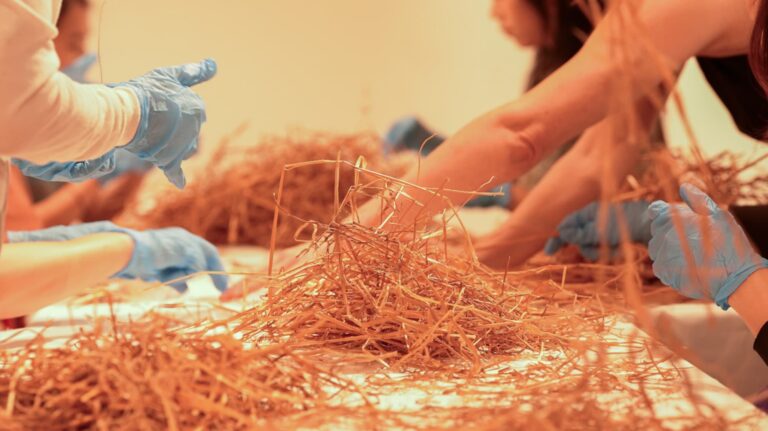
To be presented this weekend at the Singapore International Festival of Arts (SIFA), A Thousand Stitches follows Emma, an art conservation student who is tasked to restore a damaged portrait of a Japanese woman named Mizuki. As she restores the painting, Emma is transported into Syonan-to — Japanese-occupied Singapore — and into the lives of Mizuki and the portrait’s artist, Huang Wei. Through a haunting blend of live performance, illustration, and projection, the play draws its audience into a layered world of loss, remembrance, and resistance.
Kaylene Tan, writer and co-director of A Thousand Stitches, tells us more about the intricacies of memory, storytelling, and history.
Restoring the past
In the play, the protagonist Emma pores over every scratch and faded layer of the painting with a mix of fascination and determination. Her discovery of a red thread — part of the symbolic senninbari (a thousand-stitched belt) Mizuki wears in the portrait — unlocks a gateway to the past.

For Tan, making Emma an art conservation student was a deliberate and foundational choice. “Art conservation,” Tan explains, “is about uncovering what’s hidden beneath the surface — not just physically, but emotionally and historically.” The process of restoration becomes more than technical; it transforms into a metaphor for memory work. Emma isn’t just restoring an object, but also lives, feelings, and forgotten truths.
Storytelling mediums
One of the play’s most striking elements is its use of kamishibai, a traditional Japanese form of storytelling that uses illustrated boards and live narration. Often associated with children’s entertainment in pre- and post-war Japan, kamishibai also served as a propaganda tool during wartime, a duality Tan explores. Her research into Japanese visual and audio culture for A Thousand Stitches revealed the layered use of storytelling in influencing audience’s views towards the Occupation period.

In the play, Emma’s world is built from stories. From diorama-style storytelling and video recordings, to personal diary entries and painted symbols, the play immerses viewers in a web of narratives — each medium offering a different lens through which to understand truth and memory. Tan’s creative direction makes a statement: we are always surrounded by stories, often without noticing the ways they influence us.
Cross-cultural collaboration
With only two actresses — Singapore’s Xuan Ong and Japan’s Mihaya Shirata — anchoring the live performance, the emotional weight and cultural complexity of the story required a great deal of trust, sensitivity, and collaboration between them.
Shirata, unfamiliar with how the war had impacted Singapore, initially questioned whether taking on the role would be appropriate. Ong reassured her that while the occupation remains a key part of national memory, younger generations in Singapore bear no personal grudges. The duo’s honest conversation became the foundation of their on-stage chemistry.
Supported by a Japanese translator and cultural consultant, the team approached the material with care. Together, they brought depth to Mizuki and Emma’s journey, grounding the performance in mutual respect and emotional authenticity.

A theatrical feast
In A Thousand Stitches, audiences can look forward to a rich, multisensory experience that blends historical depth with present-day relevance. Traditional Japanese culture and storytelling methods, such as kamishibai and the symbolism of the senninbari, are interwoven with today’s language, humour, and even casual slang, creating a performance that feels both intimate and expansive.
Expect moments of heartfelt reflection as Mizuki learns more about the realities of the Japanese Occupation, in a character journey that invites the audience to consider how narratives are shaped by time, perspective, and omission. Stories, told through diverse mediums from archival videos to figurines and paintings, form the emotional spine of the play. Real visual materials from wartime archives add historical texture, while the actresses’ musical performances bring a poetic and haunting beauty to the stage. Their direct communication with the audience — storytelling to the audience, not just around them — makes A Thousand Stitches feel like a shared experience, rather than a distant history lesson.
Ultimately, this is a play that doesn’t just portray the past, but also enables us to examine how stories can shape our present and future.
A shared space beyond blame
During our interview, Tan emphasises that A Thousand Stitches does not seek to assign blame or declare a moral victor. Instead, it asks how art and performance can transcend conflict, offering a shared space to feel, reflect, and connect. “Everyone agrees that war is terrible,” she says. “What matters is how we find our shared humanity — and art is one of the most powerful ways to do that.”
In the end, A Thousand Stitches threads together memory, history, and imagination — not to dwell on division, but to show how the stories we inherit, tell, and retell shape our lives today. It invites us to look not only at the past, but at the quiet ways we carry its echoes into the present — and how, perhaps, we might begin to stitch something new.
___________________________________
A Thousand Stitches will be on view at the Drama Centre from 23–25 May 2025, with tickets at $48. The Singapore International Festival of Arts runs from 16 May–1 June 2025. Visit sifa.sg to purchase tickets and find out more.
Header image: Shirata teaching Ong how to interact with the form of kamishibai. Image by author.
Support our work on Patreon
Become a memberYou might also like
Lucy Davis on Art, Ecology, and Inter-Species Connections

Runs In The Family: The Paintings of Pateo Chang and Melissa Teo


